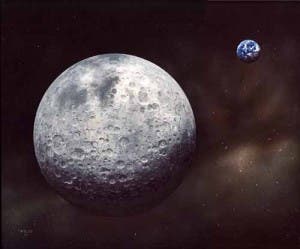
At the beginning of the year, we reported how NASA, despite being faced with drastic budget cut-backs, had an audacious plan of building a human-tended waypoint on the far side of the moon. Suspended in space, hundreds of thousands of miles away from Earth, astronauts would care to this outpost by conducting experiments in deep space, as well as on the surface during jumps to the moon itself, and provide a sort of lunchpad for eventual long term missions to neighboring asteroids or even provide the last footing before a manned landing to Mars itself. Recently, the agency has revealed more details concerning their plan, but although no exact figures concerning its cost have been reported, experts believe Congress would deny it, despite its extremely interesting prospects.
The outpost would be placed at the Earth-Moon liberation point – place in space where the gravity of the two bodies roughly cancel each other out, allowing for a semi-stationary placement. This point has been identified as the Lagrange Point 2, a spot about 38,000 miles from the moon and 277,000 miles from Earth. Compared to the current largest space station, the International Space Station, which is a mere 200 miles above Earth, this severe distance raises a lot of questions, some still answered by NASA officials.
A possible monumental feat or just another dummy plan slated for the NASA archives?
If a permanent manned mission is to be commissioned for the waypoint, then the astronauts stationed there would be at a severe risk. No one can hear your scream in space, but at least on the ISS, thanks to its rather close proximity, there’s still a chance at rescuing the crew in case of a severe malfunction. Then, there’s the issue of space radiation. That far away from Earth’s protecting magnetic shield, the outpost would be at the mercy of radiation, again something that hasn’t been addressed in NASA reports.
Concerning it’s actual conception, apparently NASA will use some parts left over from the $100 billion International Space Station tenures, which will be carried by a massive rocket and space capsule that it is developing as a successor to the retired space shuttle. For now, international partners Russia and Italia have been announced. The Orion Multi-Purpose Crew Vehicle and Space Launch System rocket, which are being developed at a cost of about $3 billion annually, are slatted for their maiden flight in 2017 – alleged construction of the outpost would start 2 years later.
Here are the six strategic principles which require implementation for the operation to have a real chance at being funded, as described in a NASA memo from a few months ago:
- U.S. commercial business opportunities to further enhance the space station logistics market with a goal of reducing costs and allowing for private sector innovation.
- Multiuse or reusable in-space infrastructure that allows a capability to be developed and reused over time for a variety of exploration destinations.
- The application of technologies for near-term applications while focusing research and development of new technologies to reduce costs, improve safety, and increase mission capture over the longer term.
- Demonstrated affordability across the project life cycle.
- Near-term mission opportunities with a well-defined cadence of compelling missions providing for an incremental buildup of capabilities to perform more complex missions over time.
An outpost on the far side of the moon: why?
The space outpost’s potential missions include regular scientific deep space experiments, some of which currently not possible on the ISS, study of nearby asteroids, dispatching robotic trips to the moon that would gather moon rocks and bring them back to astronauts at the outpost and ultimately lay the ground-work for the most ambitious space goal yet: putting man on Mars’ surface.
via Orlando Sentinel






